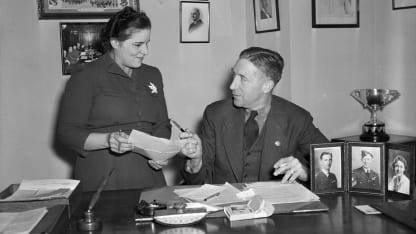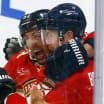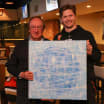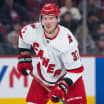Legendary hockey reporter Stan Fischler writes a weekly scrapbook for NHL.com. Fischler, known as "The Hockey Maven," shares his humor and insight with readers every Wednesday.
This week zeroes in on the forgotten -- yet noteworthy -- second president of the NHL. Mervyn "Red" Dutton helped preserve the League during World War II and endorsed rules that revolutionized the style of play.
On Feb. 4, 1943, Frank Calder, the first NHL president, died after 26 years in office and a replacement was needed.
It was a time when crowds were down because of suffocating defensive hockey. Owners needed a new vigorous leader and found someone who would enhance the front office while filling coffers as well.
The savior was Norman Alexander Dutton, commonly known as "Red" and earlier "Mervyn." In a very short time, the defenseman and 1958 Hockey Hall of Fame inductee would oversee new rules that would dramatically change the way hockey is played. Red also commissioned a complete rulebook revision. As a result, the ice would feature a new red line at center that would encourage faster play.
"For all he did for the League, Red deserves a trophy in his honor," said Ty Dilello, currently authoring a book about Dutton's former team, the New York Americans. "He was the second-ever NHL president and -- thanks to the center red line -- was responsible for ushering in the League's modern era during World War II."
Because massive enlistments decimated the Americans' roster, they folded after the 1941-42 season. Some Canadian politicians even suggested that the League suspend operations for the duration. A strong and popular leader was needed to restore equilibrium.
"Dutton was the perfect fit," Dillello said. "He was an upbeat Hall of Fame defenseman and had played for, coached and even managed the Amerks. Everyone around the League knew and loved the guy."
A decorated World War I hero, Dutton didn't need the presidency. His contracting business was flourishing, abetted by wartime projects. Still, owners pressured him to run the six-team NHL. He finally agreed with a two-pronged demand.
"I was willing to be NHL president if I still could oversee my business interests," Dutton said. "And I wanted the Governors' assurance that I could bring my Americans back after the war. Once the owners agreed, I took the job."
Behind the president's desk in Montreal's massive Sun Life Building, Red attacked issues with the same vigor he displayed on defense for the Montreal Maroons and Americans. He knew that fans were restless because the game had slowed down and realized that the rule book was an incoherent mess.
"I consulted with Frank Boucher, coach of the (New York) Rangers, about rule changes and streamlining the pace of the game," Dutton recalled. "I gave Frank the green light to fix things. I knew it was a monumental task, but it had to be done."
Said Boucher: "The rulebook had no index. There were repetitions and contradictions and there even were different penalties for the same infraction. It was close to incomprehensible, but I also knew that I had to fix it for Red and the good of the League."
The result was a compact, understandable rulebook ready for the 1943-44 season. Since Dutton also wanted more speed and less congestion, the red line did the trick. Ahead of his time, Dutton also asked for authority to employ a statistician, but the Governors tabled his request.
With the new rules as an attraction, capacity crowds began filling arenas. Owners were showing profits and despite the lower, wartime quality of play, fans understood the circumstances and found the game a pleasant diversion.
Writing in "The Trail of The Stanley Cup," Charles L. Coleman asserted, "Professional hockey was a morale booster. Although many of the stars had left to join the Armed Forces and the caliber of hockey had definitely declined, nevertheless there was widespread interest."
Red twice tried to resign to give full attention to his contracting business but each time the owners urged him to see the NHL through the wartime years. He agreed to remain even after the news that within months of each other, two of his sons, Joseph and Alex, died flying on missions for the Royal Canadian Air Force.
Despite the tragedies, Red remained in office and was more popular than ever. This was evident on June 14, 1945, when he was offered a new contract and enthusiastically accepted. With World War II almost over and uniformed NHL players soon to be discharged, Dutton also was gung-ho about reactivating his Americans.
"He had secured $7 million for financing a new Brooklyn NHL arena," Dilello said, "and with his proposed new venue in mind, Red looked forward to a rivalry with the Rangers like the Brooklyn Dodgers and New York Giants in baseball. Some of the players Red had on the 1941-42 Amerks likely would be available."
But Dutton's dream would be shattered. At the end of the 1945-46 season, he handed the presidency to Clarence Campbell, fully expecting approval for his Amerks to return for 1946-47. Unfortunately, his bid perished in the NHL boardroom.
Disappointed but undaunted, he returned to his flourishing construction business and in 1950 became one of two Stanley Cup trustees. Red retained that position for 37 years until his death at age 89 on March 15, 1987.
In 1993, the NHL posthumously awarded Dutton the Lester Patrick Trophy for service to hockey in the United States. Dilello has suggested that the League create a Red Dutton Trophy for best defensive defenseman.
"After all," Dilello concluded, "that's how Red played his position."
Dutton stayed close to the game by constructing rinks in Western Canada, including Dutton Memorial Arena in Winnipeg named after Joseph and Alex. However, he rarely attended games.
"I stayed away," he said, "because hockey was in my blood."
Then a pause: "And I couldn't sleep at night!"


















